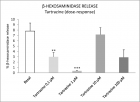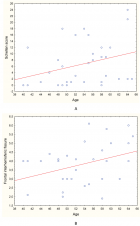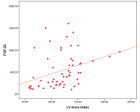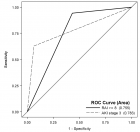About Universidad de Sonora
Universidad de Sonora
Articles by Universidad de Sonora
Evaluation of genetic diversity in germplasm of paprika (Capsicum spp.) using random amplified polymorphic DNA (RAPD) markers
Published on: 27th September, 2017
OCLC Number/Unique Identifier: 7286350759
Capsicum spp. is one of the most important economical horticulture crops due to its high consumption either by fresh vegetable or dried spice. Molecular genetic markers offer a number of applications in the genetic improvement of crop plants, which plays an important role in the areas of plant classification and breeding programs. The polygenetic characters of rare species, which are difficult to analyze by traditional methods can, be analyzed easily and classified by using molecular markers. In our study, genetic relationships of twenty-two paprika species were examined to estimate their genetic variations/similarities and to detect the polymorphism present within and among the paprika species by using RAPD-PCR markers. The results revealed that the maximum similarities among the 16 ICBD lines were 100%. The ICBD 03 had 76% similarity compared with other ICBD lines. The CC01 had comparatively low similarity with ICBD forms (30%), followed by EC01 (28%), EC02 (33%), CC02 (35%), and Kt.Pl-19 (60%). The similarity between EC01 and EC02 were 54%. Kt.Pl-19 showed different similarities compared to CC01 (41%), CC02, EC01 (38%), EC02 (29%) and ICBD 03 (40%). The different combinations were tried to optimize the RAPD-PCR profile, which helped to assessing the polymorphism/similarities within and among the Paprika germoplasms were studied.
Studies of Grafts in vegetables, an alternative for agricultural production under stress conditions: Physiological responses
Published on: 3rd January, 2018
OCLC Number/Unique Identifier: 7347068189
Vegetable production by grafting is a technique which it has made possible to resume agricultural soils which previously could not be produced due to stress generated by various abiotic factors, like a lack of water, stress by high or low temperatures, and or heavy metal contamination, among them. It has been documented and defined a number of graftings which they are tolerant to different factors; however, when it comes to auscultating information related to understand the molecular responses and observe what are the biochemical changes and physiological responses of grafted plants, it is dispersed. The current paper attempts to provide basic information documented on technique, addressing the molecular, biochemical and physiological responses, and thus get a clear perspective on the use of grafts, making this practice be used with most frequently by all its advantages.
Control of phytopathogenic microorganisms of post-harvest in tomato (Lycopersicon esculentum Mill.) with the use of citrus extract
Published on: 30th March, 2018
OCLC Number/Unique Identifier: 7671836913
Diseases are a major cause of post-harvest losses depending on season, region and management practices. Chemical control is the most used but with serious consequences for human health and the environment. This forces us to carry out more exhaustive studies on botanical products. The general objective of the present study was to evaluate the effect of citrus extracts for the control of pathogens that cause post-harvest diseases in tomato fruit. The product to be evaluated is of botanical origin from citrus extracts. Doses were evaluated (0, 666, 1000, 2000, 4000, 8000 ppm). The treatments were located at a temperature of 25°C±2 and 45% relative humidity (rH). The design used corresponded to a completely random design. The least significant difference was estimated by Tukey Multiple Range test at P=0.05. The statistical tests were performed through the SAS computer program. The results indicate that the pathogens detected and identified correspond to Alternaria tenuissima; Botrytis cinerea; Cladosporium fulvum; Colletotrichum coccodes; Fusarium oxysporum; Geotrichum candidum; Rhizopus stolonifer and Stemphylium macrosporoideum. Our conclusion is that the efficient doses correspond to 666, 2000 and 8000 ppm. With the application of citrus extracts, the damage percentage of tomato fruit was reduced in relation to the control treatments. Based on the results with the application of citrus extracts, the shelf life of the tomato was lengthened.
Detection of Clavibacter michiganensis subsp. michiganensis in tomato and chili seeds and farming area of Sinaloa, Mexico
Published on: 8th June, 2018
OCLC Number/Unique Identifier: 7814980304
Phytosanitary inspectors play an important role in diagnosing diseases in foreign plant material. However, some deficiencies have been detected in the detectionc ausing the entrance of many microorganisms. Therefore, it was of great interest to detect the presence of Clavibacter michiganensis subsp. michiganensis (Cmm) in foreign tomato and chili seed in the agricultural area of Sinaloa, Mexico, besides the growth and cell density of Cmm was evaluated in different selective media under continuous illumination and photoperiod. The results indicate that seeed of 35 varieties of tomatoes was collected; while for Chili seed were 18. This study was supported by farmers (225) which represent 79% of all growers and 32 business engaged in the sale of agro-supplies, provided seeds of varieties and hybrids. Those growers are from six areas (Culiacan, El Tamarindo, Navolato, Culiacan, El dorado and Badiraguato). For detection of Cmm in tomato seed, from 35, only four was variability considering Immunochromatography and ELISA techniques; however, considering chemical and physiological test, the result was negative. Similar results were in 18 varietes of chili seed, where eight showed variability to detect Cmm, and negative by chemical and physiological test. According to the growth and cell density of Cmm, the optimal medium was YDC under pH stable and continuous light conditions. It is recommended to consider the fusion of diagnostic techniques in the emission of a result.
Bacillus amyloliquefaciens as a plant growth promoting bacteria with the interaction with of grass salt Distichlis palmeri (Vasey) under field conditions, in desert of Sonora, Mexico
Published on: 2nd October, 2018
OCLC Number/Unique Identifier: 7900050235
The halophyte Distichlis palmeri (Vasey) is a plant resource with high potential to be harvested in the coastal areas of northwestern Mexico; enlarge the knowledge and domestication for its incursion into the agricultural sector, plays an important role for arid areas with saline intrusion problems. However, its productivity depends on the supplementary supply of nitrogen, as well as other essential macro and micronutrients. The microorganisms considered beneficial are an alternative to chemical fertilization, highlighting those Plant Growth Promoting Bacteria (PGPB). In the present study, the inoculation of the Bacillus amyloliquefaciens (B.a.) as a halobacterium PGPB was evaluated to know the response in seeds of Distichlis spicatai obtained from natural population from colorado river in Delta north of the Gulf of California. Wild seed was collected and germinated previously inoculated with B. a., and sowed in germinated beds. Later, seedlings were planted under field and salinity conditions in the coast of Hermosillo, Sonora. Three treatments were examined (T1: B.a., T2: Chemical fertilization, T3: Negative control), with four repetitions each treatment. Each repetition consisted of experimental plots of 5 x 5 m, with a separation of 1 m between them. The harvest was carried out 600 days after sowing. The results indicate that treatments inoculated with halobacteria B.a., showed significant results in crude protein, non-protein nitrogen, neutral detergent fiber and acid detergent fiber, as well as spike length and number of seeds. The results obtained suggests the feasibility of biofertilizers where biomass and seed production are significant compared to non-inoculated controls.

HSPI: We're glad you're here. Please click "create a new Query" if you are a new visitor to our website and need further information from us.
If you are already a member of our network and need to keep track of any developments regarding a question you have already submitted, click "take me to my Query."


























































































































































